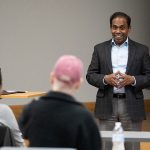Before I went to the Scleroderma Patient Education Conference I had never heard of the autoimmune disease. After a day of talking to patients, listening to lectures, and trying some therapies myself I feel confident I could explain the condition and its management techniques to a friend. Because scleroderma is a relatively rare disease, many health care providers are not aware of symptoms and coping mechanisms. As an aspiring occupational therapist, I see the value and utility this experience will provide when treating future patients. I feel fortunate for the opportunity to interact with so many knowledgeable experts on the topic and learn about current clinical trials at MUSC.
The first presentation with Dr. Janet Poole was a great introduction to common symptoms and obstacles patients with scleroderma face. Her pilot website provided scleroderma patients practical advice for managing pain and advocating for themselves. One testimonial video I found particularly helpful discussed strategies to deal with insurance companies when denied treatment. The website’s extensive amount of information and user-friendly layout would not only be a great resource for newly diagnosed scleroderma patients, but also health care providers seeking to learn more about the disease. Dr. Poole also demonstrated therapy exercises to stretch target area such as the fingers, shoulders, and mouth. I liked how she suggested stretching in everyday circumstance such as on the bus, during a TV show, or even in the shower to fit these routines into busy schedules. She also recommended commonplace objects like water bottles and cans to achieve certain stretches, which I found very creative.
Dr. Sundar, spoke on the benefits of yogic breathing and stretching for scleroderma. His research focused on how these practices increase helpful proteins in saliva and decrease stress. I couldn’t believe how much a simple act, such as mindful breathing, could affect the body on such a molecular level. While we did not measure the components of our saliva after participating in these exercises, I did feel significantly more relaxed by the end. I like how most of the exercises could be done in an office chair and appreciated his overall holist approach to treatment.
The conference wrapped up with a summary, delivered by Dr. Richard M. Silver, of current scleroderma research at MUSC and opportunities for those with the disease to participate in clinical trials. I was reminded of the importance of supporting funding for research and how much medical and technological advancement stems from these efforts.



